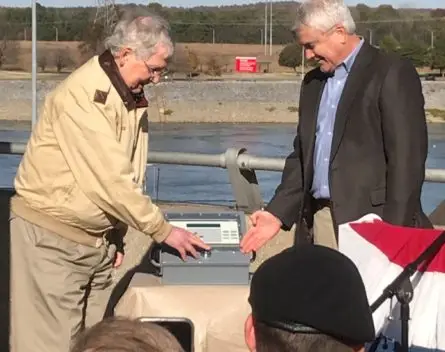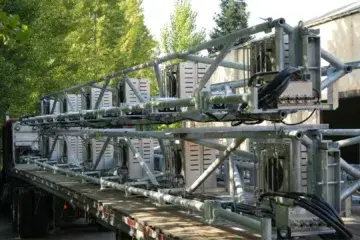Case Study: Tackling Invasive Species at Barkley Lock
Kentucky’s Barkley Lock is a key battleground in the fight against invasive carp, which are spreading towards the Great Lakes and putting native fish populations at serious risk.
Thanks to the installation of an innovative acoustic deterrent, there is hope their progress will stall.
The proposal
Fish Guidance Systems (FGS) was asked to choose a site for a field trial of the BAFF (BioAcoustic Fish Fence), with the aim of proving its effectiveness at deterring invasive carp. Barkley Lock was selected due to a promising layout and its importance to the Cumberland River.
Laboratory tests at the University of Minnesota had shown the BAFF system is 98% effective in blocking the passage of bighead carp, with success rates at almost 100% for common carp. It is ideal for waterways that must remain navigable, as it prevents the need for physical screens.
Other key features include:
- A wall of sound, generated by injecting repellent sound signals into an air bubble curtain
- High Intensity Lights for added stimulus
- Inbuilt diagnostics and remote monitoring
The system was commissioned following the allocation of $7 million of funding from the Great Lakes Restoration Initiative (GLRI) and the US Fish and Wildlife Service. FGS then worked with organisations including the US Army Corps of Engineers (USACE) and the Kentucky Department of Fish and Wildlife Resources to deliver it.
Overcoming the challenges of installation

The BAFF system consists of 30 Sound Projectors across a 192-foot span, which are combined with High Intensity Light Bars based on LED technology.
It also features an innovative Active Pressure Compensation System (APCS), which allows continuous monitoring and adjustment of the compensating pressure in the Sound Projector housings.
Prior to the Barkley Lock project, FGS relied on a passive system incorporating an air bag. Now, the APCS actively monitors the pressure in the projector in comparison to the water depth and associated pressure, and automatically adjusts the pressure in the Sound Projector so it is at the required pressure differential.
Construction got underway in the summer of 2019 and FGS coordinated its efforts with the USACE to ensure navigation of the lock could continue, with the team working during 12-hour lock closures.
On-site expertise and a flexible approach helped FGS overcome a number of unexpected challenges to ensure a successful delivery. These challenges included:
- High water levels. A level of around 307 feet was expected when construction was scheduled to begin, but it stood at 328 feet. FGS was able to commence work by deploying additional machinery, which extended the operational depth to 313.5 feet.
- Silt and rock removal. The presence of elevated levels of silt and rocks meant extensive dredging was required before the installation of concrete sections got underway.
- Inaccurate sill height measurements. Careful calculations were required after sill heights were found to differ from the specifications. The BAFF components needed to be below the sill height so they would not be damaged by barges.
With each issue successfully resolved, divers positioned the BAFF equipment on the riverbed, grouting each section in place before connecting air and power supplies. Local contractors created purpose-built control buildings and installed power cables and compressed air equipment.
The system was ultimately inaugurated by US Senator Mitch McConnell and US Congressman James Comer in November 2019, with Senator McConnell highlighting the “urgent threat” posed to businesses and anglers by invasive species in Kentucky waters.
“This BioAcoustic Fish Fence is another tool with the potential to help protect Lake Barkley and all who work or enjoy these treasured waters,” he said.
Looking to the future
The solution has been designed to optimise its operation over the course of its three-year evaluation, including modifications to the sound output. While previous tests have shown invasive carp learn to stay away from a BAFF system, increasing output when a barge passes may help maximise effectiveness.
Other potential optimisations include an inbuilt inability to add more Sound Projectors, adjust the air curtain or even automatically operate in response to the movements of the lock.
The system will be constantly monitored and evaluated, with insight into the habits of invasive species as well as the effectiveness of the solution likely to play a major role in long-term protection of the Great Lakes and the waterways of the US.



